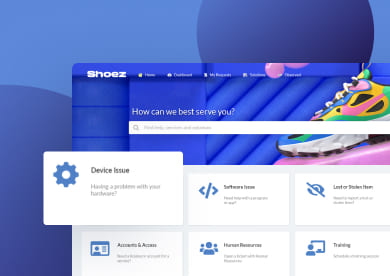ITSM best practices help teams organize their work and deliver better service experiences. They guide how IT departments handle requests, respond to issues, and manage everyday operations in a consistent way.
IT Service Management (ITSM) is the framework behind those practices. It defines how organizations design, deliver, and support IT services that align with business needs. While ITSM provides the structure through formal processes like Incident or Change Management, best practices focus on how to apply them effectively in real scenarios.
Here’s a look at some of the most useful ITSM best practices across key areas like Incident, Knowledge, Request, and Change Management.

+30 ITSM best practices
When it comes to ITSM best practices, it’s important to recognize that there isn’t a one-size-fits-all approach. Best practices can vary significantly depending on the unique needs, goals, and resources of a particular organization.
Each IT team may develop its own set of best practices tailored to its specific environment, influenced by factors like the industry it operates in, the size of the company, and the technologies it uses.
Among the numerous ITSM frameworks, ITIL (formerly known as Information Technology Infrastructure Library) is the most widely adopted. Because of its widespread use and recognition, many organizations choose to implement ITIL best practices as part of their ITSM strategy. However, it’s important to note that while ITIL is influential, it’s not the only framework out there. COBIT, ISO/IEC 20000, and other frameworks also offer valuable guidance, and organizations often blend practices from multiple sources.
Ultimately, ITSM best practices should be seen as guidelines rather than strict rules. Organizations should evaluate the various practices available, considering the specific challenges and objectives of their IT operations.
ITSM Service Design best practices
Service Design defines how new or updated services are planned before they’re deployed. The design phase is where the blueprint for the service is created, and getting this right is essential for long-term success.
A consistent Service Design ensures that services are easy to use and can be efficiently maintained and updated as business requirements evolve.
1. Start with clear business requirements
Before designing any service, confirm what the business needs and why. Misaligned objectives at this stage often lead to rework or poor adoption later.
2. Document all service components and dependencies
Include software, hardware, support procedures, and SLAs in your design documentation. This ensures everyone understands what’s needed for smooth delivery.
3. Test designs before implementation
Simulate or pilot new services to verify functionality, performance, and user experience. Early testing catches issues before rollout.
4. Collaborate with all stakeholders
Involve end-users, developers, and operations teams early in the design phase. A collaborative process helps balance usability, cost, and technical feasibility.
ITSM Incident Management best practices
Effective Incident Management keeps disruptions under control and helps restore normal operations quickly.
The primary goal of this practice is to minimize the impact of incidents on the business and ensure that services are restored to normal operation with minimal downtime. Incidents can range from minor issues, such as a single user unable to access a particular service, to major outages that affect multiple users or critical systems.
1. Standardize incident categorization and prioritization
Use clear categories and priority levels to route tickets to the right teams. A structured classification system helps agents identify patterns, improve reporting accuracy, and ensure critical incidents are addressed first.
2. Automate ticket assignment and escalation
Automation tools can instantly assign incidents to available agents or escalate them based on urgency or SLA targets. This reduces response time and keeps high-priority issues from being overlooked.
3. Maintain detailed incident records
Comprehensive documentation of incidents — what happened, how it was fixed, and who was involved — builds a reference base for future cases. It also helps identify recurring problems that might require a permanent fix.
4. Establish clear communication channels
Users should always know how to report an issue and what to expect after doing so. Providing multiple reporting options (portal, chat, or email) makes it easier for users to reach IT and improves transparency.
5. Review major incidents regularly
After resolving a high-impact incident, hold a brief review to identify what caused it and how to prevent it in the future. Turning incidents into learning opportunities builds process maturity over time.
ITSM Problem Management best practices
Problem Management aims to identify and eliminate the root causes behind recurring incidents. While Incident Management deals with resolving individual incidents, Problem Management aims to prevent incidents from occurring in the first place by addressing their underlying causes. Effective Problem Management practices prevent repeated disruptions and improve long-term stability.
1. Separate problem and incident workflows
Keep Problem Management distinct from incident handling. Incidents focus on restoring service quickly, while problems require deeper investigation and analysis to find underlying causes.
2. Use a known error database (KEDB)
Document known problems and temporary fixes in a central database. This allows agents to apply proven workarounds faster while a permanent solution is in progress.
3. Prioritize problems based on impact and frequency
Focus efforts where they matter most—on issues that cause the most downtime or affect the most users. A data-driven prioritization method helps allocate resources effectively.
4. Collaborate with other teams during analysis
Bring in application, infrastructure, or network experts when investigating complex problems. Shared perspectives often uncover causes that a single team might miss.
5. Monitor problem trends
Regularly review problem records and reports to identify recurring patterns. It's a proactive approach that will help you spot early warning signs before they escalate into widespread incidents.
Best practices for ITSM Request Management
Managing service requests efficiently improves user satisfaction and gives IT teams better visibility over workloads.
1. Use predefined service catalogs
A clear service catalog with standardized request forms speeds up submission, routing, and approval. It also helps users understand what services are available and what information they need to provide.
2. Automate approvals and fulfillment steps
Workflows can handle repetitive tasks like assigning requests or sending approval notifications. This helps teams focus on higher-value activities while ensuring requests move through the process without delay.
3. Communicate status updates automatically
Keeping users informed about their request status reduces frustration and lowers the number of “follow-up” tickets. Automatic notifications make the process transparent without adding work for agents.
Best practices for ITSM Knowledge Management
Knowledge Management involves capturing, organizing, and sharing knowledge to support decision-making, problem-solving, and service improvement.
Effective Knowledge Management keeps valuable information accessible to both agents and end-users, reducing ticket volume and improving response quality. In fact, 91% of users say they would use a knowledge base if it meets their needs.
1. Create articles based on recurring issues
One best practice in ITSM for creating knowledge is to analyze incident trends and convert frequent problems into knowledge base articles. Doing so allows users to find quick answers and helps agents resolve tickets faster with verified solutions.
2. Structure articles for easy search and readability
Organize content with clear titles, headings, and categories so users can quickly find what they need. Including step-by-step instructions, screenshots, or links to related articles makes information more accessible and reduces the time agents and users spend searching for solutions.
3. Keep knowledge articles up to date
Regular reviews prevent outdated or inaccurate content from circulating. Assign article owners to review and update documentation at defined intervals.
4. Encourage agents to contribute and use knowledge
Build a culture where agents document fixes as part of closing a ticket. Rewarding contributions and tracking article usage helps keep your knowledge base relevant and active.
“Lead with transparency, right? Describe the process from end to end […] The transparency is really key […] not making anything heavy or cumbersome. Share all the wins and successes with everyone. Make everybody feel good about their contributions.”
Michelle Stumpf, Head of Knowledge Management at Celonis
Live episode of Ticket Volume
ITSM Change Management best practices
Change Management ensures that modifications to the IT environment —whether software updates, infrastructure changes, or configuration adjustments — are planned, reviewed, and implemented safely.
The Change Management process typically involves submitting a change request, conducting an impact analysis, and obtaining approval from a Change Advisory Board (CAB) before the change is implemented.
1. Formalize the change request process
Every change should begin with a well-documented request that outlines the purpose, scope, risks, and rollback plan. This promotes accountability and helps stakeholders make informed decisions.
2. Assess risk and impact before approval
Evaluating technical and business risks prevents service interruptions. Involving representatives from different departments helps gauge the broader impact and ensures nothing is overlooked.
3. Review and learn from completed changes
Post-implementation reviews help teams understand what went well and what didn’t. Documenting lessons learned improves future change planning and strengthens process maturity.
"You can never be perfect, right? So you gotta continuously improve. Some people call it maturity, and that's good too, but I think it's supposed to be continuously proven. So that's what you do. You keep on going back to this life cycle. Because over time, technology changes, people change, processes change. So you gotta keep on observing people, process, technology, and then make sure that you know where can you eliminate waste and add value."
Waseem Ahmed
Director of IT Service Management at BECU
Episode 56 of Ticket Volume
ITSM best practices for Service Level Management
Service Level Management (SLM) ensures that IT services meet agreed performance and availability standards. This is typically achieved through Service Level Agreements (SLAs), which are formal contracts that outline the specific levels of service to be delivered, including metrics such as uptime, response times, and resolution times.
1. Define measurable and realistic SLAs
Set targets that reflect both business expectations and IT capabilities. Unrealistic SLAs lead to frustration, while measurable ones help track and improve performance.
2. Communicate SLAs clearly
Make service commitments visible to both IT staff and users. When expectations are clear, users understand response times, and IT teams can plan resources accordingly.
3. Monitor performance continuously
Use dashboards and automated reports to compare actual results with SLA targets. Continuous monitoring helps detect deviations early and keep performance on track.
IT Asset Management best practices
IT Asset Management (ITAM) helps organizations control their hardware, software, and cloud assets throughout their lifecycle. Following best practices reduces costs and improves compliance.
Additionally, Asset Management helps organizations comply with regulatory requirements by ensuring that they have accurate records of all IT assets. ISO/IEC 20000 provides guidelines for managing IT assets effectively, making Asset Management a key practice for any ITSM strategy.
1. Maintain a complete and accurate asset inventory
Track all IT assets—from laptops and servers to software licenses—in a centralized system. Accurate data supports better decision-making and risk management.
2. Automate asset discovery and updates
Use discovery tools to detect assets and keep records up to date automatically. Automation reduces manual work and prevents data inaccuracies.
3. Monitor license compliance
Regularly review software usage and licensing agreements to avoid penalties or unnecessary renewals. Accurate tracking ensures compliance while identifying cost-saving opportunities.
4. Integrate ITAM with other ITSM processes
Connecting asset data to incident, change, and request management gives teams full visibility into how assets affect service delivery.
5. Plan for the entire asset lifecycle
Include acquisition, deployment, maintenance, and disposal in your process. A complete lifecycle view helps manage costs and ensures environmental and data security standards are met.
“We have to start thinking about processes – both services and processes such as Asset Management – as no longer a linear process. Instead of just buying, using, and discarding, we need to ask, ‘Do we even need this asset? Can we wait? Can we reuse it?’”
Dr. Tuuli Bell, PhD, Tuuli Bell Ltd.
Episode 84 of Ticket Volume - IT Podcast
Using InvGate Service Management as your ITSM software
InvGate Service Management is an ITSM platform designed to help organizations manage their IT services with greater efficiency and visibility. It brings together core ITIL-aligned processes — such as Incident, Request, Problem, and Change Management — into a single, easy-to-use interface.
The platform supports automation, workflow customization, and SLA tracking, allowing IT teams to deliver consistent service quality and maintain clear communication with users.
Beyond standard ITSM capabilities, InvGate Service Management focuses on improving collaboration and accessibility. It offers a customizable self-service portal where users can submit requests, check status updates, and find knowledge base articles without involving the IT team directly. Agents, in turn, benefit from intuitive dashboards, AI-powered assistance, and reporting tools that simplify workload management and performance analysis.
The platform integrates with a wide range of tools, making it adaptable to different business environments.
Ask for your 30 day free trial and explore the tool for yourself!















